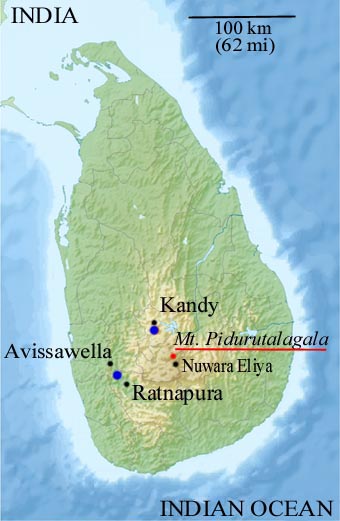Page 10 / 10
Rémy had seen an Epiphyllum looking like the previous one in Kandy, more than 100 kilometers away from the first site ( second blue point on the map) As by chance, he was getting the first bloom of this Epiphyllum in his collection at the time when I was asking him the question on the different locations; he sent me photographs of the bloom, unfortunately too blurred to be shown here, but there remained no doubt: the bloom was the same one with the same red and yellow characteristic pistil.
Thus, Epiphyllum phyllanthus ssp. hookeri was also to be found in Kandy, and not only near Ratnapura.

The climate of Kandy is very close to the one of Ratnapura. (tropical
wet)
Rémy told me that it had obtained the cutting in the garden of a guest house hotel, on a hill next to the city. The plant was growing on a tree in this garden and Rémy had wrongly believed that it was Epiphyllum oxypetalum.
I also learned that there was a botanical garden in Kandy and another one in Nuwara Eliya, at approximately 100km (62 mi) in the South of Kandy, very close to the Pidurutalagala Mount.
So, from all that precedes, we can deduce that:
Epiphyllum oxypetalum is not the only botanical
species of Epiphyllum abundantly widespread in Asia.
Epiphyllum phyllanthus ssp. hookeri is also to be found in the island of Sri
Lanka.
On the other hand, several assumptions remain, concerning
the origin of this plant in the island:
* first introduction by Europeans
* introduction by Sri Lankians
* natural dissemination of the plant starting from the botanical gardens if
the plant is possibly present in these gardens
* dissemination by Sri Lankians at the time of their travels within the island
Thus, there are still many mysterious points ...............
However, the assumption of the British introduction seems to be most probable one, because:
1- The botanical garden of Kandy (more precisely Paradeniya), whose origin dates back to 1371, was officially founded in 1843 and many plants were installed there, coming from the botanical gardens of Kew (Kew Gardens, close to London) in particular; the botanical garden of Kandy had been managed for a long time by the British.
2-The word “hookeri” appearing in the name of the plant (............ssp. hookeri) which is the topic of this article, precisely refers to Sir William Jackson Hooker (1785-1865), a British botanist whose name appears in many cacti species. He had precisely been the curator of Kew Gardens from 1841 to 1865.
As for the dissemination of the plant in the island, all assumptions are allowed.
However, it appears very probable to support the scenario of the dissemination by seeds coming from fruits eaten by frugivorous animals which would have transported seeds in their dejections. There is indeed in the island the attested presence of frugivorous monkeys and bats, especially in the region which it's question.
________________________________________________________________________________________
PHOTOS OF ALL MY BOTANICAL EPIPHYLLUM
PHOTOS OF ALL MY HYBRID EPIPHYLLUM
REPRODUCTION BY SOWING OF EPIPHYLLUM OXYPETALUM
TIKAL : AN EPIPHYLLUM BIOTOPE AND ALSO AN ARCHAEOLOGICAL MAYA SITE
A VIETNAMESE LEGEND ABOUT EPIPHYLLUM OXYPETALUM
_____________________________
________________________________________________________________________________________________
Sources of the article:
Wikipedia, concerning the geographical, historical,
cartographic data of the island of Sri Lanka as well as the data about botanical
gardens of Kandy, of Kew and the references to William Jackson Hooker.
http://nom-des-nuages.perso.sfr.fr/ombrothermique/
Advanced worldwide meteorology website for the climatic
data of several cities of Sri Lanka.
Joel Lodé in posts on the forum of the "Cactus
Francophone" 2014/02/02, concernind the dissemination by
frugivorous animals.
And, last but not least, correspondence with Rémy Wuarin,
a friend of mine, a cacti Swiss collector, who gave me the idea to write this
article and provided me with the framework of this article as well as invaluable
photographs.
__________________________________________________________________________________________________